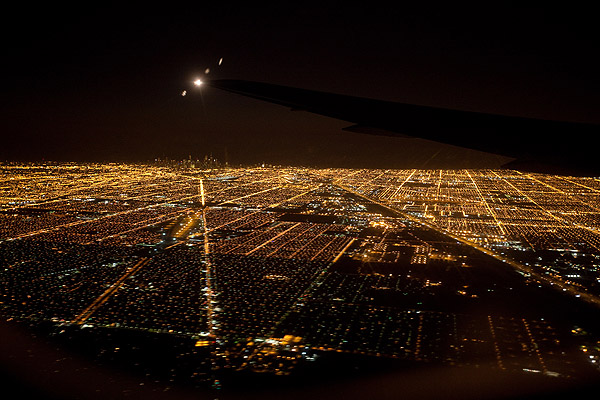
A bit of good news as you or your loved ones prepare to embark on your holiday journeys:
The global accident rate for January through November was 22% better than the same time last year and marked the safest period since a United Nations aviation agency began collecting data in 1945, according to the International Air Transport Assn., an airline trade group that issued a report based on the U.N. data.
My wife hates flying; I love it. On cross-country trips, I follow the plane's trip, trying to identify where it is from the geological formations along the ground—one reason I like Virgin, which even in coach has a map tracking the plane's route, sacrificing brain teasers for accuracy. When I see something particularly spectacular, I take a picture and hand her the camera. Sometimes I take pictures of landforms so I can bring them home and find them on Google Maps (like the remarkable Burke's Garden).
I didn't fly until I was 16, and it used to make me a bit jumpy, since I often fly into small airports on small planes. But I've gotten much more calm about it, and part of the reason is that I read a lot about airline accidents. That may seem paradoxical, but it's brought me a measure of peace to know how elaborate and detailed the process is for airline-crash postmortems. When I was just out of college and working a mindless office job, I listened to Pat Milton's In the Blink of an Eye on tape—a good week's worth of listening—while filing papers (mostly sorting medical papers about pathology, which is why a 350-page book about an airline crash didn't make my mood any darker).
It's an account of how the FBI and NTSB investigated the crash of TWA Flight 800, long a conspiracy magnet, and it's an absolutely fascinating detective story, following the rebuilding the plane from parts scavenged at the bottom of the ocean to determine the mechanical flaw that brought it down. 95 percent of the plane was found as it was reconstructed in a flight hangar, one of the great reverse-engineering projects in history.
If a long book about an airline crash is a bit much for the flight home, there are shorter pieces that make similar points. There's the New Yorker piece "The Crash Detectives" by Jonathan Harr, author of the great A Civil Action. There's Wil S. Hyton's long New York Times Magazine piece on Air France 447, and more recently a long analysis based on black-box recordings of the flight by Jeff Wise.
One of the authors who got me interested in airline crashes was Patrick Smith, author of Salon's long-running "Ask the Pilot" column. In a typically rational and excellent piece, he examines Alec Baldwin's American Airlines freakout—which caused a pile-on of bad press for the airline—and comes to the defense of the flight attendants. One aspect of the prohibition against electronic devices during takeoff and landing hadn't occurred to me:
In theory, a poorly shielded notebook computer can emit harmful energy, but the main reason laptops need to be put away is to prevent them from becoming high-speed projectiles in the event of an impact or sudden deceleration, and from hampering an evacuation. Your computer is a piece of luggage, and luggage needs to be stowed so it doesn’t kill somebody or get in the way. The same holds for iPads and Kindles. Sure, a book can weigh as much as a Kindle, but this is where the line is drawn.
A book weighs as much, but it's a lot more forgiving than an e-book reader if it hits you in the head at high speeds. Equally intuitive is Smith's explanation for why music devices aren't permitted during takeoff and landing, which explained another aspect of flight that confused me: "Similar to the requirement to raise your window shades, it’s in the interest of situational awareness." It's related to why your seat has to be in upright position:
There are two main reasons why flight attendants pester people to keep those seats up—to keep injuries to a minimum during a crash and to clear the maximum amount of space for a quick exit.
The science is pretty basic, as explained by Brian Manning, a flight attendant for Mesa Airlines. "When the seat is up, it is locked. When the seat is back, it's not locked. In the event of an emergency, an unlocked seat has more force during impact, and the thrusting forward of that seat can cause passenger injury."
These prohibitions are enforced during the beginning and end of flights for a good reason:
Third, focus on your action plan during the first three minutes of flight and the last eight minutes. That's when around 80 percent of accidents happen. In other words, before takeoff and landing, don't take off your shoes; don't put on a face mask to sleep; and don't wear earphones.
All this reading about airline crashes and irritating in-flight rules, oddly enough, has brought me a great deal of contentment when I go to board. It's better living through science. And if that doesn't work, I use art, pretending that I'm in a Galaxie 500 video:
Photograph: TenSafeFrogs (CC by 2.0)


